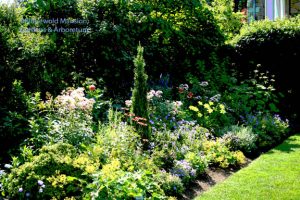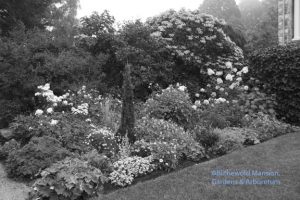Design in the details
 Open any one of William Cullina’s books and you’ll get a good idea of the sort of person he is (our kind) and if you’re me, you’ll read cover to cover and learn something new on each page. Invite him to speak, and you’ll have the pleasure of meeting one of the most articulate, knowledgeable, and down-to-earth horticulturists on Earth. For Blithewold’s annual Garden Design Luncheon fundraiser yesterday, Bill tailored a talk drawn from both his latest book, Understanding Perennials: A New Look at an Old Favorite, as well as his latest design work as Plants and Garden Curator at Coastal Maine Botanical Gardens (where a single garden’s plants budget exceeds our wildest dreams by many 10’s of K’s). I’m still trying to process all that he packed into his lecture and although I’m inclined to use this post as a memory jog, I’ll try my best to stick to a few highlights instead.
Open any one of William Cullina’s books and you’ll get a good idea of the sort of person he is (our kind) and if you’re me, you’ll read cover to cover and learn something new on each page. Invite him to speak, and you’ll have the pleasure of meeting one of the most articulate, knowledgeable, and down-to-earth horticulturists on Earth. For Blithewold’s annual Garden Design Luncheon fundraiser yesterday, Bill tailored a talk drawn from both his latest book, Understanding Perennials: A New Look at an Old Favorite, as well as his latest design work as Plants and Garden Curator at Coastal Maine Botanical Gardens (where a single garden’s plants budget exceeds our wildest dreams by many 10’s of K’s). I’m still trying to process all that he packed into his lecture and although I’m inclined to use this post as a memory jog, I’ll try my best to stick to a few highlights instead.
From bare-dirt beginnings of garden design all the way through to the whys and wherefores of fuzz and variegation on foliage, Bill illustrated no-brainer suggestions and basic botany in a way that I think, like me, everyone must have been having “Why didn’t I think of that?” and “Oh, now I get it!” epiphanies at each turn of the slides. One slide from Bill’s own garden illustrated exactly how a layer of good compost on terrible hardpan has the power to transform mere dirt into soil plants will thrive in. With another set of slides Bill suggested layering a photograph of the garden site with tracing paper to sketch rough ideas. (- Now, I take dozens of pictures almost daily and I have a roll of tracing paper in my closet, but have I ever put the two together? Have you?) And because texture, much more than color, is a major garden design consideration, he also suggested using photo editing software to blur the focus and desaturate color to work out what textural elements are working in the garden and which ones aren’t. (Another idea I wish I had already had.)
He said that one way to add contrast into the garden is to include shrubs and trees in the design – something we’re all inclined to do lately for ease of maintenance reasons – the only danger being that eventually the garden could become a woodland. He recommends preserving the garden’s scale by coppicing or cutting back to the ground those shrubs and trees, during dormancy, every year or two or three. To me it really seems worth fearlessness and further research to determine which plants (such as his example of Magnolia macrophylla) respond especially well to that treatment.
I remember some of what I learned in the botany survey classes I took in college but Bill has a way of making the biology of plant processes relevant to our gardens, utterly fascinating and useful from a design standpoint. The next time any of us buys a plant we’ll be thinking of where it was grown and whether it’s been forced into a fragile stage of life. We have a better understanding of the mechanisms of foliage and how that determines placement within our gardens, and he illuminated some of the paths bugs – good and bad – use to find our plants. All of this is and much, much more – “everything you ever wanted to know about perennials but were afraid to ask” – is covered in his latest book and if you couldn’t make it to the luncheon, I hope you’ll at least treat yourself to a copy of that.
Did you attend the lecture or have you read any of Bill’s books? What were your favorite highlights?


